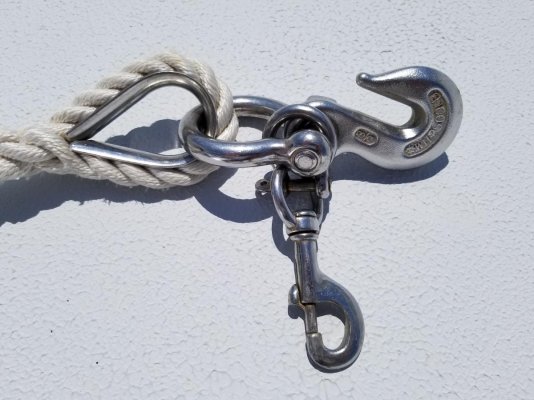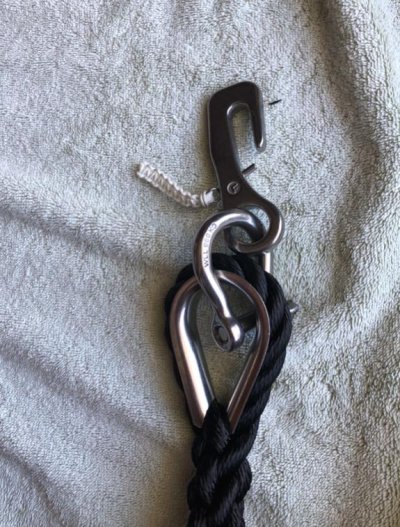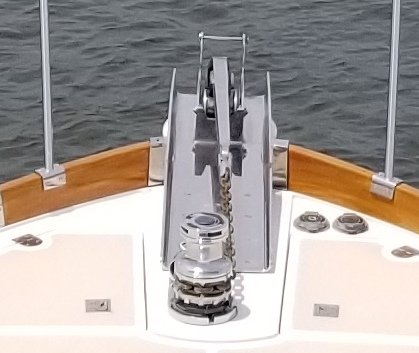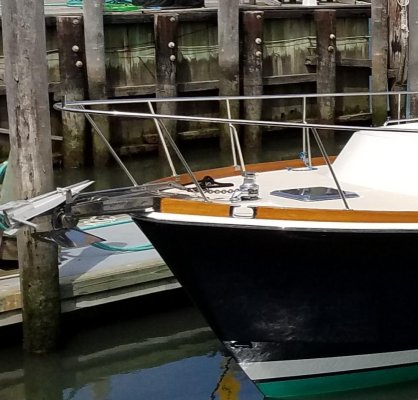You are using an out of date browser. It may not display this or other websites correctly.
You should upgrade or use an alternative browser.
You should upgrade or use an alternative browser.
Snubber
- Thread starter cbouch
- Start date
The friendliest place on the web for anyone who enjoys boating.
If you have answers, please help by responding to the unanswered posts.
If you have answers, please help by responding to the unanswered posts.
dhays
Guru
- Joined
- May 26, 2015
- Messages
- 9,575
- Location
- Gig Harbor, WA
- Vessel Name
- Kinship
- Vessel Make
- 2010 North Pacific 43
Does a nice stainless eye grab hook work well for a snubber or is it worth the extra money for a c.s.johnson chain hook.
Depends on your setup and conditions. I use one to secure the anchor while underway, setting the anchor, and for short term “lunch hook” applications. For those it works great. For regular anchoring I don’t use it.
Edit: BTW, this has been discussed a lot. No problem discussing it more but you might try doing a search here on TF for Chain hook, bridle, and snubber and read the threads that comes up.
Last edited:
O C Diver
Guru
- Joined
- Dec 16, 2010
- Messages
- 13,334
- Location
- Fort Myers, Florida
- Vessel Name
- End Of The Line
- Vessel Make
- Trinka 10 Dinghy
menzies
Guru
I bought a Mantus for our 3/8 chain set up last spring.
I will probably sell it on Ebay or here next spring. It is just so friggin' big. Getting it past the roller and anchor "bounce bar" is really difficult.
We will revert to our double shackle set up going forward.
It's a pity because the Mantus really is very simple to attach and take off and holds the snubber to chain well. It is just too large for the application.
I will probably sell it on Ebay or here next spring. It is just so friggin' big. Getting it past the roller and anchor "bounce bar" is really difficult.
We will revert to our double shackle set up going forward.
It's a pity because the Mantus really is very simple to attach and take off and holds the snubber to chain well. It is just too large for the application.
Last edited:
motion30
Guru
- Joined
- Jan 14, 2010
- Messages
- 1,216
I install my mantus chain hook just below the roller but I understand every setup is different
jleonard
Guru
- Joined
- Jun 25, 2008
- Messages
- 5,180
I use a regular galvanized grab hook. Same way OC is rigged but without the second clip.
Amazon has a SS 5/16" chain hook for $13.45, delivered if you have Prime. Half the cost of Defender's. See https://www.amazon.com/Stainless-St...eway&sprefix=5/16"+chain+hook,aps,231&sr=8-22
David
David
Delfin
Grand Vizier
- Joined
- Jan 20, 2010
- Messages
- 3,851
I use a Wichard chain hook for my 3/8" BBB bridle.
FWIW, the 8mm Wichard chain hook has a safe working 1/4 that of 3/8" BBB and the 10mm about 1/3. A soft shackle is as easy to attach and would be twice as strong as the BBB.
wkearney99
Guru
- Joined
- Feb 17, 2018
- Messages
- 2,189
- Location
- USA
- Vessel Name
- Solstice
- Vessel Make
- Grand Banks 47 Eastbay FB
I'm watching this thread to consider what I should set up for our boat. I'm leaning toward this approach, but getting two lines made, each with the thimble on one end, sized to reach back to our bow cleats (through fairleads) without leaving a lot of extra. That'd give me some flexibility on setups.
But whatever I end up with, it's tedious getting it set up with the way our bow roller and rails are configured. The roller is just far enough forward, and low enough, to make it a hassle to get a line with the hook out there without it falling off the chain or risking loss of a boat hook pole.
I saw a Mantus hook at a local ship store, yowza, it's HUGE. No way it'd fit over the roller.
Delfin
Grand Vizier
- Joined
- Jan 20, 2010
- Messages
- 3,851
That is why many find a soft shackle to be so much easier to deal with than hooks, as well as being much, much stronger.But whatever I end up with, it's tedious getting it set up with the way our bow roller and rails are configured. The roller is just far enough forward, and low enough, to make it a hassle to get a line with the hook out there without it falling off the chain or risking loss of a boat hook pole.
I saw a Mantus hook at a local ship store, yowza, it's HUGE. No way it'd fit over the roller.
dhays
Guru
- Joined
- May 26, 2015
- Messages
- 9,575
- Location
- Gig Harbor, WA
- Vessel Name
- Kinship
- Vessel Make
- 2010 North Pacific 43
I'm watching this thread to consider what I should set up for our boat. I'm leaning toward this approach, but getting two lines made, each with the thimble on one end, sized to reach back to our bow cleats (through fairleads) without leaving a lot of extra. That'd give me some flexibility on setups.
That is what I’ve done. 2 1/2” 3 strand lines with a thimble on one end and a loop on the other. Each is 25’ long. This provides a huge amount of flexibility. Just because they are 25’ long doesn’t mean you have to use the entire length. Most of the time I don’t use the entire length, but when it is blowing the full 25’ is nice to have.
I also have a low bow roller with a keeper so I do have to reach forward to feed back each eye over the roller. Then they are attached to the chain with a soft shackle. Then when the anchor chain is let out the shackle with the two eyes easily goes over the roller and down. So while I do have to lean forward to feed back the eyes of the line, I’m not having to try to lean forward to attach a hook or shackle to the chain but can do that right in front of the windlass.
FWIW, I use an inexpensive chain claw on a 6’ line to secure the anchor when up as well as to set the anchor. Again, the claw secures the anchor between the windlass and the roller so no reaching involved.
Delfin
Grand Vizier
- Joined
- Jan 20, 2010
- Messages
- 3,851
I'm not familiar with the "soft shackle" concept. Please expand with a photo or two.
They're made of Dyneema, which is why they are so freaking strong. To attach a soft shackle to the chain, you just pass the loop end through the chain and the thimble, then loop the eye over the knot. Takes about 5 seconds to attach. You only need a 1/4" Dyneema (or equivalent) soft shackle to exceed the strength of the chain many fold. Here's a link to one possible manufacturer: https://www.marlowropes.com/product/dynaline-shackles
You can find them for under $15, or, you can easily make them.
After we run out the chain, I pass the live end of a single line snubber over a roller that is positioned over the chain roller, then attach the yacht thimble to the chain, then run out the chain with an overhang of around 6 feet to allow for stretch in the snubber, which is kind of their whole point, IMO.
dhays
Guru
- Joined
- May 26, 2015
- Messages
- 9,575
- Location
- Gig Harbor, WA
- Vessel Name
- Kinship
- Vessel Make
- 2010 North Pacific 43
I'm not familiar with the "soft shackle" concept. Please expand with a photo or two.
I have been using soft shackles for a number of years. They are very simple in concept. You have a short length of line with a stopper knot at one end and a loop at the other. Run it through the items you want to connect and then slip the loop over the stopper knot.
Here is a link to the type of soft shackles that I’ve been making for years. This design was developed by Allen Edwards and is very easy and quick to use. The strength of the shackle is about equal to the strength of the line. So if you use 3/16” dyneema, it is going to have about a 5,400lbs average breaking strength.
https://l-36.com/soft_shackle_9.php
When I want a stronger soft shackle I use a different style that I developed but is based on the “Better Soft Shackle” by Allen Edwards and the “Stronger Soft Shackle” that was developed by Allen Edwards, Brion Toss, and Even Starzinger (all sailors with Brion Toss a professional rigger). It has an average breaking strength of about 230% of the line strength. So if you use 3/16” dyneema line it will have an average breaking strength (as tested) of over 12,000 lbs.
https://l-36.com/high_strength_soft_shackle.php
Here is an old shackle that I have here at the house.

dhays
Guru
- Joined
- May 26, 2015
- Messages
- 9,575
- Location
- Gig Harbor, WA
- Vessel Name
- Kinship
- Vessel Make
- 2010 North Pacific 43
i have been using soft shackles for a number of years. They are very simple in concept. You have a short length of line with a stopper knot at one end and a loop at the other. Run it through the items you want to connect and then slip the loop over the stopper knot.
Here is a link to the type of soft shackles that i’ve been making for years. This design was developed by allen edwards and is very easy and quick to use. The strength of the shackle is about equal to the strength of the line. So if you use 3/16” dyneema, it is going to have about a 5,400lbs average breaking strength.
https://l-36.com/soft_shackle_9.php
when i want a stronger soft shackle i use a different style that i developed but is based on the “better soft shackle” by allen edwards and the “stronger soft shackle” that was developed by allen edwards, brion toss, and even starzinger (all sailors with brion toss a professional rigger). It has an average breaking strength of about 230% of the line strength. So if you use 3/16” dyneema line it will have an average breaking strength (as tested) of over 12,000 lbs.
https://l-36.com/high_strength_soft_shackle.php
here is an old shackle that i have here at the house.
View attachment 93801

Simi 60
Guru
- Joined
- Jul 1, 2016
- Messages
- 5,482
- Location
- Australia
- Vessel Make
- Milkraft 60 converted timber prawn trawler
Victory hooks support the chain better than a chain hook, more of a gentle caress over the whole link vs point loading.
Ours has seen 80+ knots.
https://victory-products.com/products/ch2303

Ours has seen 80+ knots.
https://victory-products.com/products/ch2303

Delfin
Grand Vizier
- Joined
- Jan 20, 2010
- Messages
- 3,851
Victory hooks support the chain better than a chain hook, more of a gentle caress over the whole link vs point loading.
Ours has seen 80+ knots.
https://victory-products.com/products/ch2303

And while it likely doesn't matter, mostly, weaker than the chain.
FF
Guru
- Joined
- Oct 12, 2007
- Messages
- 22,552
A sailboat snap shakle is fast and does not fall off.
Splice one onto each line. 3/8 for 10K days and 1/2 inch for 20Kdays.
Be sure the spring like will not reach the running gear if it goes overboard.
Splice one onto each line. 3/8 for 10K days and 1/2 inch for 20Kdays.
Be sure the spring like will not reach the running gear if it goes overboard.
wkearney99
Guru
- Joined
- Feb 17, 2018
- Messages
- 2,189
- Location
- USA
- Vessel Name
- Solstice
- Vessel Make
- Grand Banks 47 Eastbay FB
Victory hooks support the chain better than a chain hook, more of a gentle caress over the whole link vs point loading.
Ours has seen 80+ knots.
There are no clips I've found anywhere demonstrating it's installation and/or use. Just that one stock picture.
wkearney99
Guru
- Joined
- Feb 17, 2018
- Messages
- 2,189
- Location
- USA
- Vessel Name
- Solstice
- Vessel Make
- Grand Banks 47 Eastbay FB
These pictures (somewhat poorly) illustrate the hassle of trying to make use of a snubber on the all-chain rode of our EB47.
I don't have any better bow/side view pix, and this one shows the boat during delivery when it still had both the Fortress and the plow anchors in place on the roller. I only keep the plow anchor up there now. It's tough to tell from the side view, but easier from astern, but there's a rod that at the far forward end, presumably there to help avoid the anchor/chain from coming up above the roller. This makes it tedious trying to get anything attached to the chain. Any line attached has to be either fed in from up/over that rod or fed out with the chain. Either one makes for problems. Fed out with the chain means having to carefully grab it with a boat hook, lest it drop into the water. Getting it forward and under that rod is a longer reach than you might think, just looking at these pictures.
I think the rod can be removed, and that would greatly ease putting a snubber on the chain without needing to be reaching out over the end of the roller. With the plow anchor in use it's hook shape seems to be more than sufficient for keeping it 'in place' on the roller. As shown in the picture, if I had the Fortress up there I'd probably have to keep the rod installed to avoid letting it flap upward if seas picked up.
I don't have any better bow/side view pix, and this one shows the boat during delivery when it still had both the Fortress and the plow anchors in place on the roller. I only keep the plow anchor up there now. It's tough to tell from the side view, but easier from astern, but there's a rod that at the far forward end, presumably there to help avoid the anchor/chain from coming up above the roller. This makes it tedious trying to get anything attached to the chain. Any line attached has to be either fed in from up/over that rod or fed out with the chain. Either one makes for problems. Fed out with the chain means having to carefully grab it with a boat hook, lest it drop into the water. Getting it forward and under that rod is a longer reach than you might think, just looking at these pictures.
I think the rod can be removed, and that would greatly ease putting a snubber on the chain without needing to be reaching out over the end of the roller. With the plow anchor in use it's hook shape seems to be more than sufficient for keeping it 'in place' on the roller. As shown in the picture, if I had the Fortress up there I'd probably have to keep the rod installed to avoid letting it flap upward if seas picked up.
Attachments
Delfin
Grand Vizier
- Joined
- Jan 20, 2010
- Messages
- 3,851
These pictures (somewhat poorly) illustrate the hassle of trying to make use of a snubber on the all-chain rode of our EB47.
I don't have any better bow/side view pix, and this one shows the boat during delivery when it still had both the Fortress and the plow anchors in place on the roller. I only keep the plow anchor up there now. It's tough to tell from the side view, but easier from astern, but there's a rod that at the far forward end, presumably there to help avoid the anchor/chain from coming up above the roller. This makes it tedious trying to get anything attached to the chain. Any line attached has to be either fed in from up/over that rod or fed out with the chain. Either one makes for problems. Fed out with the chain means having to carefully grab it with a boat hook, lest it drop into the water. Getting it forward and under that rod is a longer reach than you might think, just looking at these pictures.
I think the rod can be removed, and that would greatly ease putting a snubber on the chain without needing to be reaching out over the end of the roller. With the plow anchor in use it's hook shape seems to be more than sufficient for keeping it 'in place' on the roller. As shown in the picture, if I had the Fortress up there I'd probably have to keep the rod installed to avoid letting it flap upward if seas picked up.
A properly rigged snubber reduces the load on the chain proportional to its length, so it's a puzzle why so many boat builders don't bother to provide an easy way to use what I think is an important safety device.
wkearney99
Guru
- Joined
- Feb 17, 2018
- Messages
- 2,189
- Location
- USA
- Vessel Name
- Solstice
- Vessel Make
- Grand Banks 47 Eastbay FB
A properly rigged snubber reduces the load on the chain proportional to its length, so it's a puzzle why so many boat builders don't bother to provide an easy way to use what I think is an important safety device.
No argument there. Likely more focus on design aesthetics than anything else.
The annoying/puzzling part is the GB manual does mention securing the rode to a deck cleat, with no suggestion/mention as to how. Oh, I get that manuals are often vague, and aren't going to explain 'basic stuff'. Doesn't make it any less annoying though.
jleonard
Guru
- Joined
- Jun 25, 2008
- Messages
- 5,180
No argument there. Likely more focus on design aesthetics than anything else.
The annoying/puzzling part is the GB manual does mention securing the rode to a deck cleat, with no suggestion/mention as to how. Oh, I get that manuals are often vague, and aren't going to explain 'basic stuff'. Doesn't make it any less annoying though.
I have only seen a few boat manuals, never anything about that in any of them.
I don't have a manual for my boat I figured it out.

wkearney99
Guru
- Joined
- Feb 17, 2018
- Messages
- 2,189
- Location
- USA
- Vessel Name
- Solstice
- Vessel Make
- Grand Banks 47 Eastbay FB
Same here.
Thrown in at the deep end.
Some are probably better than others. I've had decent luck with ones for various boats I've owned. Useful to have schematics and diagrams for various systems. Not always accurate, especially if any previous owners have 'helped' but usually better than nothing.
Even better has been having them in PDF form and saved on a dropbox, onedrive, google drive or other cloud service. I've made it a habit to make a folder for each vendor and drop in the PDFs for all of the gear on board. Including install docs, not just owners manuals or spec sheets. Never know when you'll need to now measurements or something. Saves me a trip back to the boat or home.
Similar threads
- Replies
- 20
- Views
- 2K
- Replies
- 5
- Views
- 682





